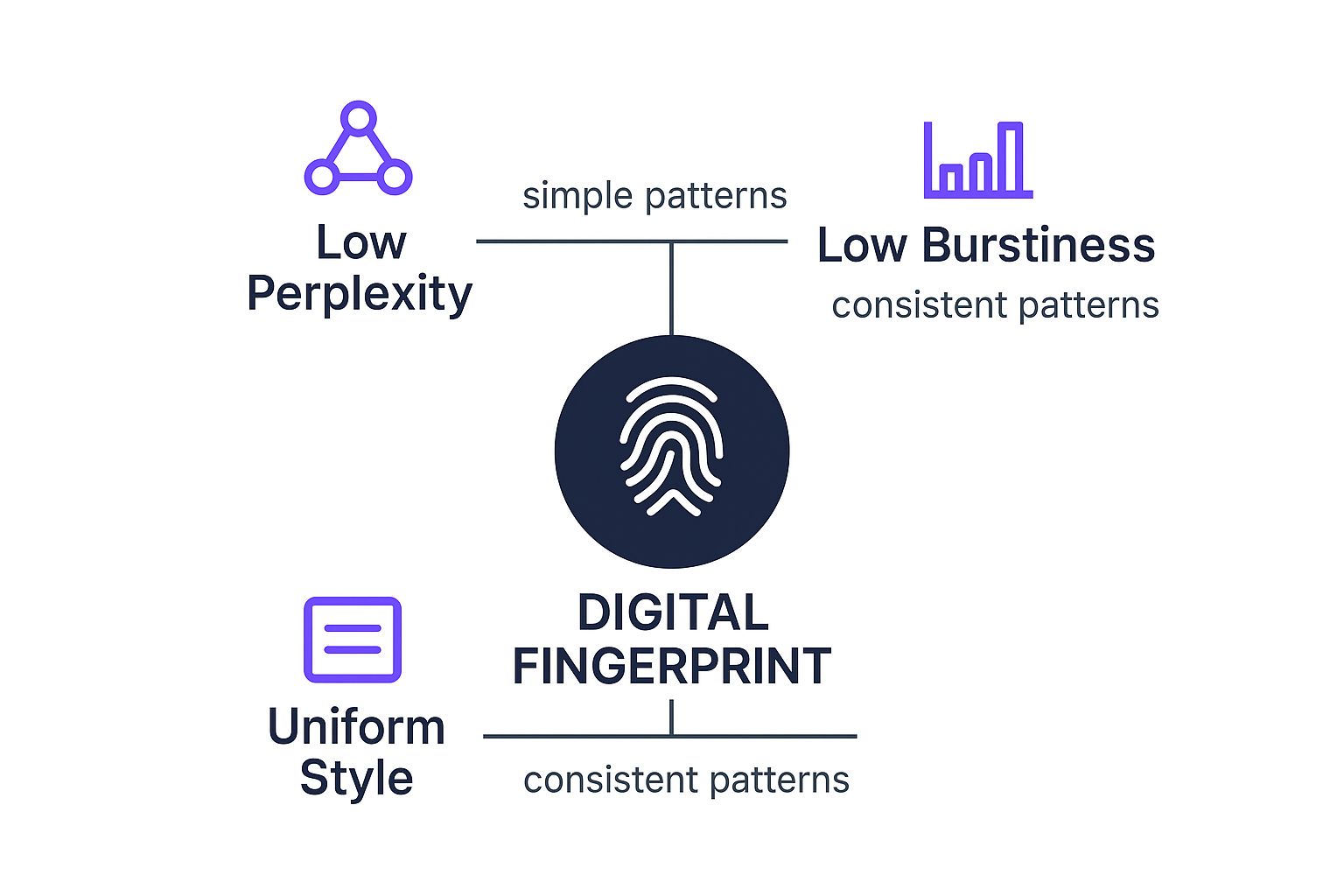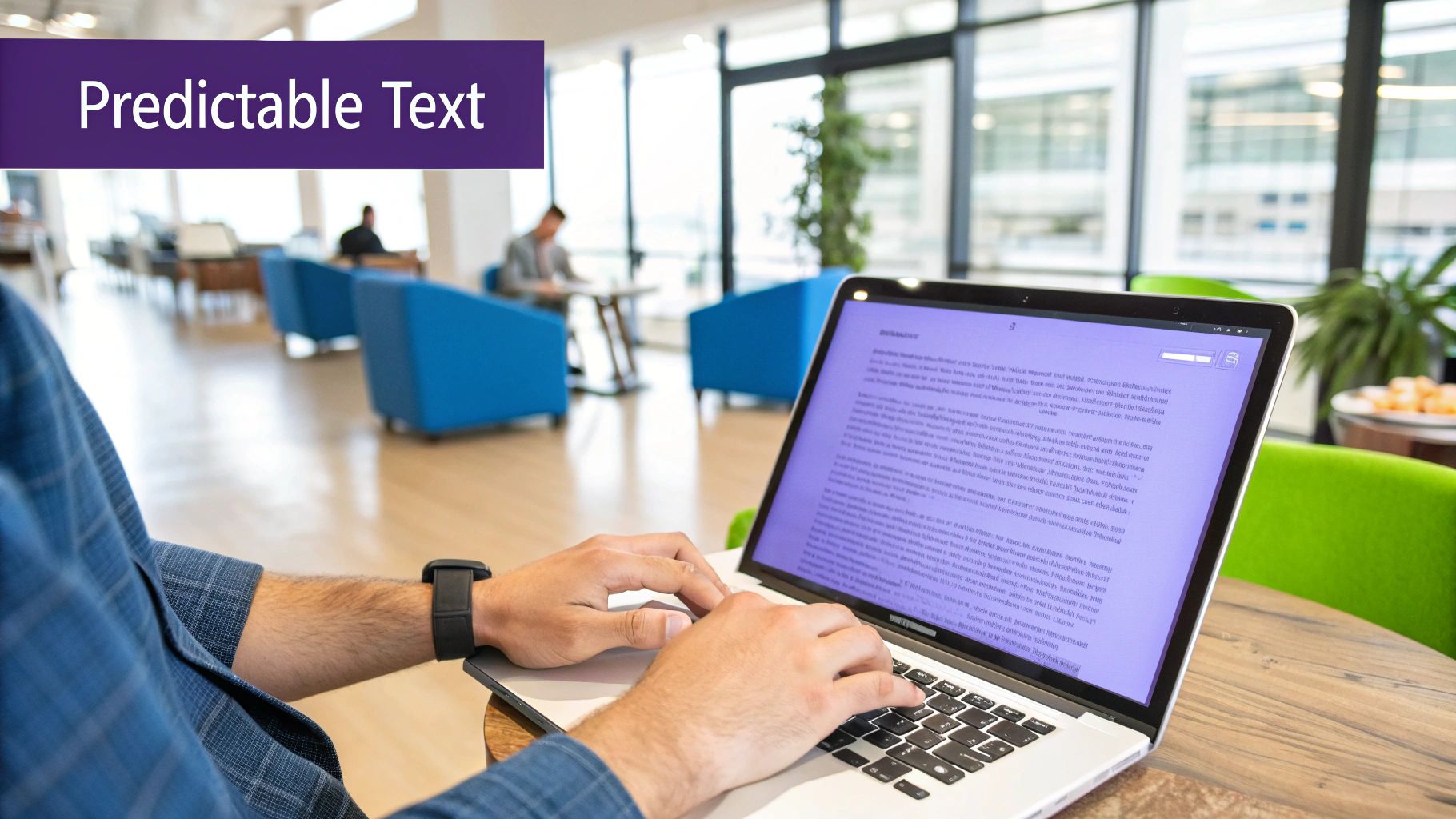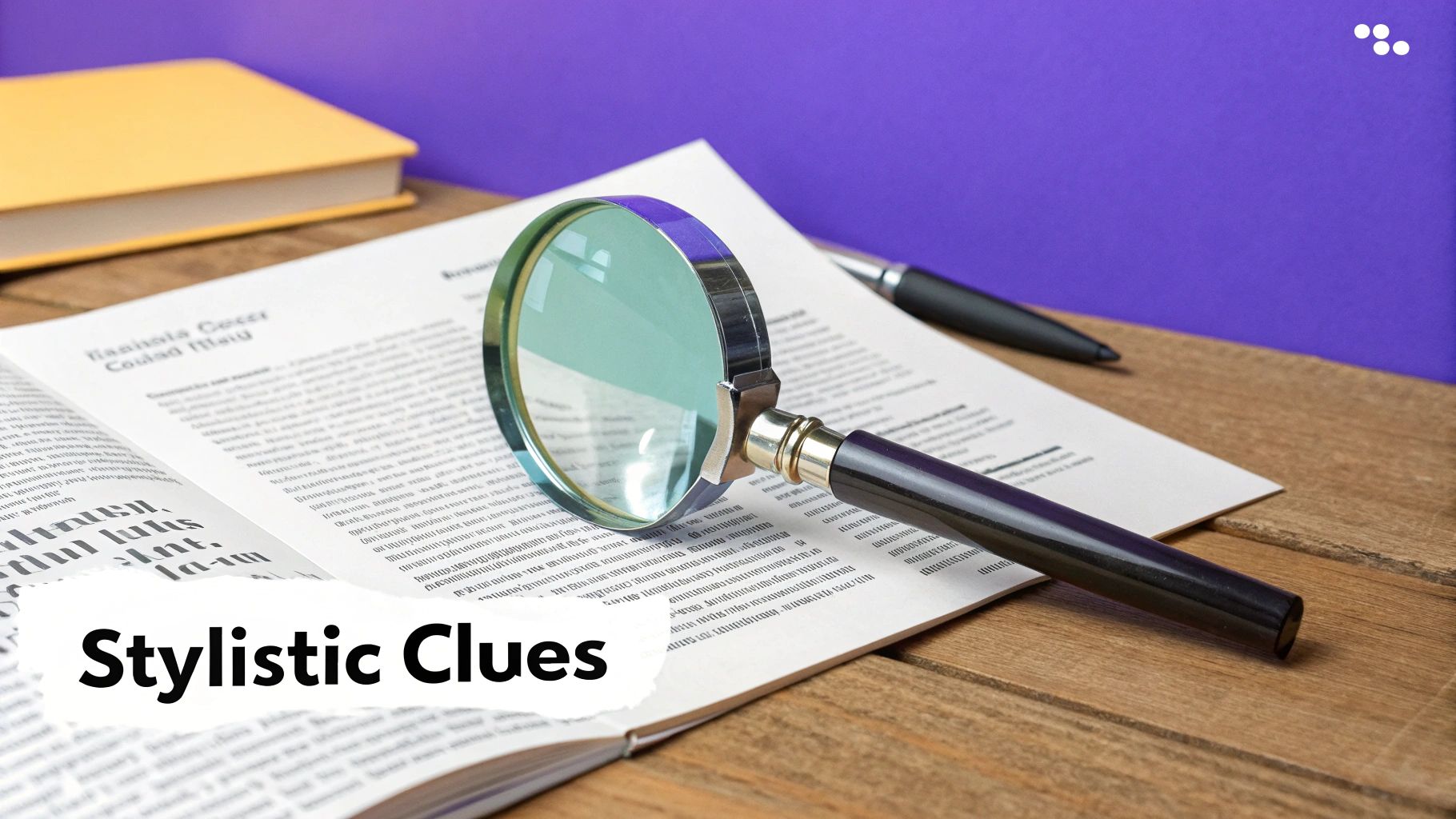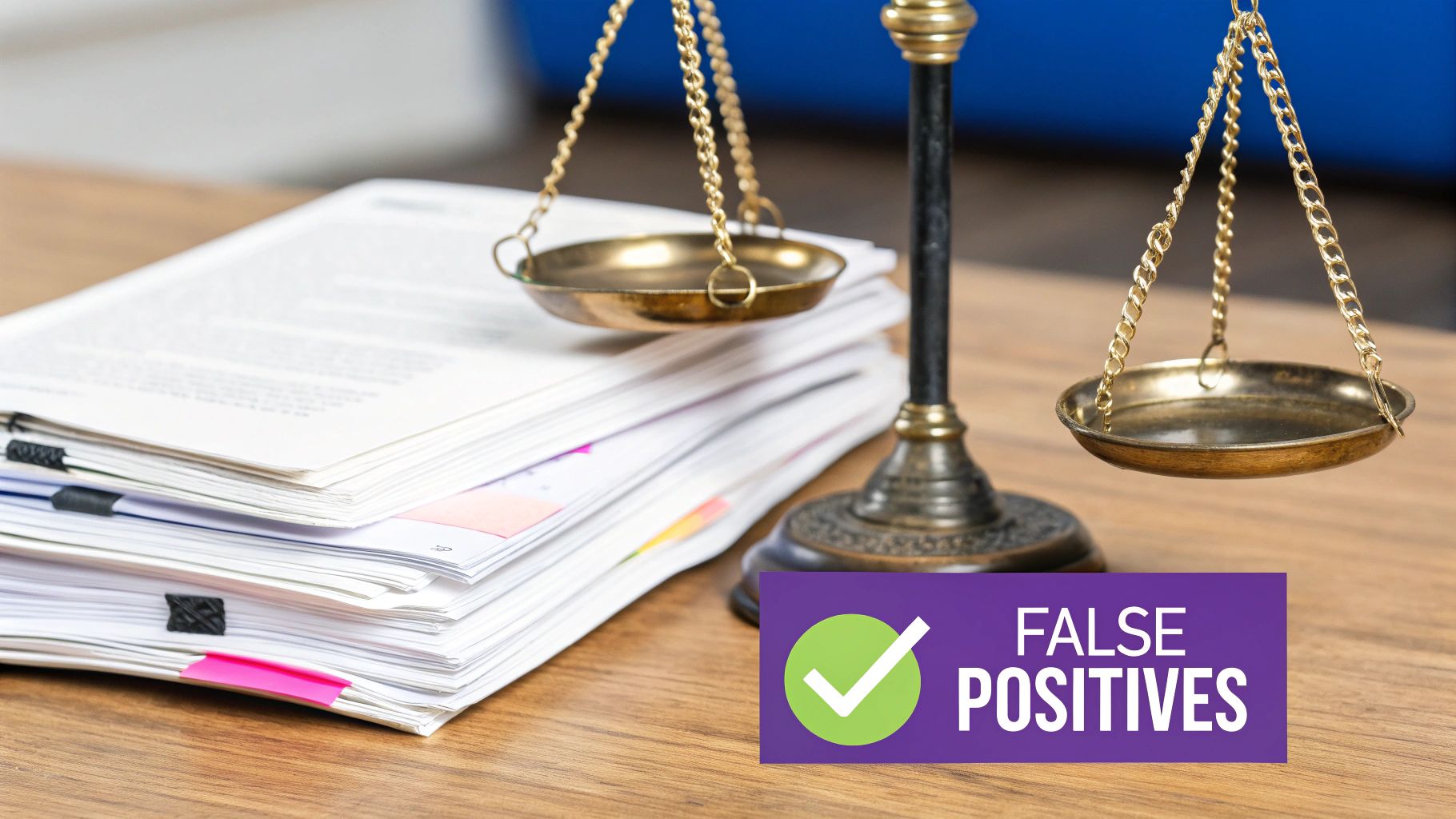What Do AI Detectors Look For? Key Insights Explained
At its core, AI-generated text has a tell-tale signature: it's just a little too perfect. It's predictable. AI detectors are trained to spot this unnatural uniformity by analyzing the statistical "fingerprints" an algorithm leaves behind.
These tools zero in on two key signals: low perplexity, which flags overly predictable word choices, and low burstiness, which identifies a lack of variety in sentence length and structure. This robotic consistency is often the biggest giveaway that separates machine writing from a human author.
How AI Detectors Find Digital Fingerprints
Think of an AI detector as a digital forensic analyst. Instead of dusting for fingerprints at a crime scene, it's scanning text for the subtle statistical patterns that algorithms can't help but create. Human writing is wonderfully messy and unpredictable. We use surprising turns of phrase, mix short, sharp sentences with long, flowing ones, and our unique voice shines through.
AI, for all its power, still struggles to mimic that organic chaos. Its main goal is to predict the next logical word, which creates a pattern. The detector's job is to spot that pattern and build a case based on that unnatural consistency.
The Telltale Signs of AI Writing
Because AI models are built on prediction, their output is often grammatically flawless but creatively flat. It lacks the rhythm and spark of human expression. Detectors are specifically trained to look for these giveaways:
- Low Perplexity: This is really just a fancy way of saying the text is predictable. AI often defaults to common, "safe" words, making it easy for another model to guess what's coming next. Human writing is far more surprising and uses a richer vocabulary, which results in higher perplexity.
- Low Burstiness: This measures the rhythm and flow of the writing. Humans tend to write in bursts—a few short, punchy sentences followed by a longer, more descriptive one. AI text, on the other hand, often has a monotonous, metronome-like pace with sentences of very similar length and structure. This uniformity equals low burstiness.
This infographic gives a great visual breakdown of how these concepts come together to form the digital signature that detectors are looking for.

To help you quickly grasp these concepts, here’s a summary of the main signals that AI detectors are trained to find.
Key Signals AI Detectors Analyze at a Glance
| Signal Category | What It Means for a Text | Why AI Detectors Look For It |
|---|---|---|
| Perplexity | Measures the predictability of word choices. Low perplexity means the text is simple and unsurprising. | AI models are trained to pick the most probable next word, leading to highly predictable (low perplexity) content. Humans are less predictable. |
| Burstiness | Refers to the variation in sentence length and structure. Low burstiness means sentences are uniform and rhythmic. | Human writing has natural ebbs and flows (high burstiness). AI writing often sounds monotonous with similarly structured sentences. |
| Vocabulary & Phrasing | Examines the richness and uniqueness of the words used. AI often defaults to common phrases and a limited vocabulary. | AI tends to repeat certain phrases or use words that are grammatically correct but lack nuance, a pattern detectors can spot. |
By analyzing these signals together, tools like an AI image detector and text-based analyzers can calculate a confidence score, giving you a statistical probability of whether the content came from a person or a machine.
When AI detectors scan a piece of content, they're not just reading words; they're looking for the underlying statistical fingerprint. Two of the most important concepts they use are perplexity and burstiness.
Think of these as the digital equivalent of a writer's unique voice. They help a machine distinguish between the creative spark of a human and the predictable patterns of an algorithm.
Perplexity: The Predictability Score
A text with low perplexity is predictable. The word choices are common, safe, and exactly what you’d expect. It’s like a paint-by-numbers artwork—it follows the rules perfectly, but it lacks originality. AI models are trained to pick the most statistically likely word to come next, which is why their writing often has this straightforward, almost simplistic quality.
Human writing is different. We're full of surprises. We use interesting metaphors, play with phrasing, and draw from a much wider vocabulary. This makes our writing less predictable to a computer, giving it a higher perplexity score. We don't just choose the most obvious word; we choose words for their feeling, rhythm, and impact.
Burstiness: The Rhythm of Writing
If perplexity is about word choice, burstiness is all about sentence structure. It measures the rhythm and flow of the writing by looking at the variation in sentence length.
Think of it like a conversation. A real person's speech has a natural cadence—we use short, quick sentences to make a point, followed by longer, more descriptive ones to explain our thoughts. This creates a dynamic, engaging rhythm. That’s high burstiness.

AI, on the other hand, often produces sentences that are frustratingly similar in length and structure. The result is a monotonous, metronome-like beat. This uniformity is a classic sign of machine-generated text, and it's something detectors are specifically trained to catch.
An AI detector acts like a literary critic, analyzing not just the words themselves but the statistical music behind them. The flat, predictable tempo of machine writing is often its biggest tell.
This stylistic consistency is exactly what AI detectors are built to find. Large studies that have looked at millions of student essays have confirmed that AI writing consistently shows lower perplexity. These systems hunt for signals like 'burstiness'—the natural, irregular shifts in sentence complexity that humans create all the time. You can learn more about the trends and statistics behind AI detection.
When a detector combines these two metrics, it can build a pretty strong case.
- Low Perplexity + Low Burstiness: This is a huge red flag for AI-generated content. The writing is predictable in both its vocabulary and its sentence structure, giving it a robotic feel.
- High Perplexity + High Burstiness: This combination screams human. The text is creative, the sentence flow is varied, and it has an organic rhythm that today’s AI models struggle to fake.
Ultimately, these statistical markers are the foundation of AI detection. They allow the software to look past grammar and spelling to analyze the invisible architecture of the text and make a call on its origin.
Digging into Stylistic and Semantic Clues
Going beyond the numbers of perplexity and burstiness, AI detectors put on their literary detective hats. They start hunting for the stylistic and semantic giveaways that scream "robot." Think of it like a skilled art forger trying to copy a masterpiece. They can get the big picture right, but they almost always miss the subtle, unique brushstrokes that define the original artist. AI models do the same—they produce perfectly grammatical sentences that just feel... empty.
This is where the real sleuthing begins. An AI detector starts scanning for an unnatural, almost sterile smoothness in the writing. It’s looking for a missing voice, a lack of personality, and the tendency to lean on the same words and phrases over and over. Human writing is full of quirks, opinions, and tiny biases that make it feel real. AI text often lacks that soul.

That missing authorial voice is one of the biggest red flags. Our writing is colored by our experiences and feelings, which naturally shapes our word choice and tone in ways an algorithm just can't fake.
Vocabulary and Structural Patterns
One of the most obvious tells is how an AI uses transition words. Models love to sprinkle in words like "moreover," "furthermore," and "in conclusion" to give their writing structure. We use them too, of course, but an AI often uses them with a robotic rhythm that sounds off to a person and is a dead giveaway for a detector.
Detectors also dissect sentence structures, looking for repetition. An AI might fall into a rut, starting every sentence the same way or sticking to a rigid subject-verb-object formula. The result is text that is technically perfect but feels completely manufactured.
AI-generated text often reads like a flawless but boring book report. It checks all the boxes and uses perfect grammar, but it’s missing the unique cadence and personality of a human writer who has actually wrestled with the ideas on the page.
Checking for Logical Coherence
The final piece of this puzzle is semantic coherence. This is all about checking if the ideas in the text actually hang together in a logical, human-like way. The detector is trying to figure out if the argument flows naturally or if there are strange little gaps in reasoning that a person wouldn't make.
For example, an AI might list a series of facts that are all individually correct but never come together to form a cohesive point. It can jump between related topics without the smooth, intuitive segues that make human writing easy to follow.
These semantic checks help the tool answer a crucial question:
- Does this text demonstrate a real, contextual understanding of the topic?
- Or is it just stringing together words that are statistically likely to appear next to each other?
When a detector pulls all of this together—the stylistic analysis, the semantic checks, and the perplexity and burstiness scores—it builds a comprehensive profile of the text. It's this combined strategy that lets the tool see past the surface-level polish and spot the hidden fingerprints of an algorithm.
How Advanced AI Detectors Actually "Think"
While simple clues like perplexity and burstiness give us a starting point, today's best AI detectors operate on a whole different level. They aren't just simple pattern-checkers. Instead, they are powered by their own sophisticated deep learning models, making them behave more like a seasoned literary critic than a spell-checker.
Think of an expert who has spent a lifetime reading, absorbing literally millions of pages of text. They wouldn't just look at sentence length; they develop an intuitive, deeply ingrained feel for what makes writing sound authentic and human. Advanced detectors are trained in a similar way, but on a scale that's hard to fathom—trillions of words from both people and AI.
This massive training gives them an incredible ability to pick up on the subtle, almost invisible linguistic fingerprints left behind by generative AI. They learn to spot the statistical "ghosts in the machine"—the faint traces of the mathematical coin-flips an algorithm makes every time it decides which word comes next.
The Never-Ending Arms Race
And this is where the cat-and-mouse game truly begins. AI detection is locked in a constant arms race with the generative models it's trying to identify. Every time a more advanced model like GPT-4o is released, it gets better at erasing its own tracks and mimicking human writing more flawlessly.
This means the detectors have to go back to school. They must be constantly retrained with new examples to keep pace. A detector that was excellent at spotting text from an older model might be completely fooled by its successor because the very "tells" it was trained to find have been smoothed over or eliminated.
The fundamental challenge is that detector developers are always playing catch-up. As the AI models get better and better at sounding human, the signals become fainter, making it harder to tell a statistical artifact from natural, human variation.
This pressure has forced detection tools to analyze text with incredible precision. For instance, some of the latest tools combine multiple deep learning approaches to get stunningly accurate results. One such hybrid model managed to achieve 99.8% accuracy when analyzing texts from GPT-3.5. But this performance is a moving target. In one case, an open-source detector's accuracy took a nosedive right after a new version of GPT was released, perfectly illustrating this ongoing chase. You can dive into the full research on these evolving detection models to see the hard data behind this trend.
Looking Beyond the Words
So, what do AI detectors look for when they get this advanced? They're essentially analyzing the probability of a word sequence. Put simply, they're asking, "Based on the words that came before, what were the mathematical odds that a human would have chosen this exact string of words?"
How a Human Chooses: A person might intentionally pick a less common but more powerful word to make a point or create a certain style. Our choices can be unpredictable and creative.
How an AI Chooses: Even with a massive vocabulary, an AI is fundamentally wired to lean towards the most probable, statistically "safe" word choice.
The difference is tiny, often imperceptible to us, but it's mathematically real. The deep learning models inside detectors are trained to sense this slight statistical preference. They don't just see the words on the page; they see the faint mathematical shadow of the algorithm that put them there. It's this continuous process of learning and adapting that allows modern detectors to stay in the game.
The Reality of Accuracy and False Positives

So, how reliable are these digital detectives in the real world? While many tools boast impressive accuracy rates, the reality is a lot more nuanced. Understanding the performance limits of AI detectors is just as important as knowing what they look for, especially when it comes to the nagging problem of false positives.
The gap between what’s claimed and what happens in practice can be huge. A detection score should be treated as a strong indicator, not as airtight proof. These tools operate on statistical probabilities, which means they can—and absolutely do—make mistakes. Their conclusion is a highly educated guess, not a certainty.
This is exactly why blind trust in a detection score is a bad idea. A high "AI-generated" percentage might just mean the writing style is simple and predictable, not that a machine wrote it. That subtle difference is everything for anyone using these tools to make important decisions.
The Challenge of False Positives
One of the biggest headaches in AI detection is the rate of false positives—when a tool mistakenly flags human-written text as being generated by AI. This happens more often than you'd think and shines a light on some of the inherent biases baked into these systems.
For example, these tools often stumble over text written by non-native English speakers. Writing from someone still learning the language naturally features simpler sentence structures and a more direct vocabulary. To an AI detector, these traits look statistically similar to the low perplexity and burstiness of machine-generated text, leading to a false accusation.
A critical study found that over 61% of TOEFL essays written by non-native English speakers were incorrectly flagged as AI-generated, highlighting a massive bias in current detection models.
This bias isn't malicious; it's a byproduct of the data used to train the detectors. If a model is primarily trained on complex, native-English writing, it learns to view anything less complex as an anomaly—and potentially as AI. This raises serious ethical questions about fairness and accuracy in a global world.
The privacy of user data is also a major concern, as some tools may not safeguard the documents you upload. You can learn more about how to protect your information by understanding our approach to data privacy.
Comparing Real-World Detector Performance
Independent research consistently reveals a wide gap in how well different tools actually perform. When you dig into the numbers, it becomes clear that only a handful can reliably do their job.
The table below provides a snapshot of the reported performance of several popular tools, highlighting their strengths and the known issues that users should be aware of.
Reported Performance of Common AI Detection Tools
| Detection Tool | Reported Strengths in Studies | Known Weaknesses or Biases | False Positive Concerns |
|---|---|---|---|
| Copyleaks | Consistently high accuracy in identifying text from various GPT models, especially in academic contexts. | Can be overly sensitive to formulaic or structured human writing. | Moderate, but can flag technical or legal documents written by humans. |
| Originality.ai | Strong performance in detecting content from newer models like GPT-4. Often cited for its thoroughness. | Has shown bias against non-native English writing styles. | Higher than average, particularly with simpler or more direct human writing. |
| Turnitin | Integrated into academic workflows, good at spotting common AI patterns in student essays. | Struggles with heavily edited or "humanized" AI text. Performance can vary. | Lower than some competitors, but still a known issue in academic settings. |
| GPTZero | Effective at analyzing perplexity and burstiness. Popular for its user-friendly interface. | Less accurate with shorter text snippets and mixed human-AI content. | Present, especially when analyzing straightforward or list-based human writing. |
As you can see, no single tool is a silver bullet. Each has its own set of trade-offs.
In one comprehensive test of 16 different detection tools, only three—Copyleaks, Originality.ai, and Turnitin—could consistently tell the difference between student writing and various ChatGPT versions.
On the other end of the spectrum, OpenAI’s own (now discontinued) detector only had a 26% chance of correctly identifying AI-written content. Even worse, it incorrectly flagged 9% of human writing as being machine-generated. These numbers show just how careful you need to be.
The bottom line is that no AI detector is perfect. They are helpful for an initial analysis, but their results should always be put into context and confirmed with human judgment, especially when the stakes are high.
Frequently Asked Questions About AI Detection
When you start using AI detectors, a lot of questions pop up. Just how reliable are these things? Can they be tricked? This section cuts through the noise and gives you straightforward answers so you can make sense of the results you’re seeing.
Think of it this way: the more you understand what a detector is looking for, the better you can use it. Whether you're a teacher trying to ensure academic integrity, an editor verifying submissions, or just someone curious about a piece of content, let’s get into the most common questions.
Can AI Detectors Ever Be 100 Percent Accurate?
The short answer is no. AI detectors can't be 100% accurate. Their entire process is built on spotting statistical patterns—quirks and habits common in machine-generated text that are less common in human writing. They operate on probability, not certainty.
A lot of things can throw off the score. The sophistication of the AI model that created the text, the topic itself, and even a person's unique writing style can all muddy the waters. More importantly, these tools can generate false positives, flagging perfectly good human writing as AI-generated.
The best way to use an AI detector is to treat its score as a strong hint or one piece of the puzzle, not as a final verdict. Always back it up with your own critical judgment.
Does Editing AI Text Help It Pass as Human?
Yes, and it works surprisingly well. If you thoroughly edit a piece of AI-generated text, you can often get it past a detector. This "humanizing" process works because you're actively disrupting the very patterns the detector is trained to spot.
When you rewrite sentences to mix up their length and structure (what some call increasing burstiness) or swap out common words for more interesting ones (increasing perplexity), you're effectively scrubbing away the AI's statistical fingerprints. The more you revise, the higher the chance it will read as human-written.
Do AI Detectors Also Check for Plagiarism?
This is a common point of confusion, but AI detection and plagiarism checking are two completely different things. Some tools bundle both, but they are fundamentally separate functions. Getting this right is crucial for interpreting your results correctly. Many of our users need different combinations of features, which is why we offer a few different AI Image Detector pricing plans.
Here’s how to think about them:
- AI Detection: Scans the text's style and structure. It's looking for tells like predictable phrasing, overly consistent sentence length, and other statistical giveaways that suggest a machine wrote it.
- Plagiarism Checking: Compares a text against a huge database of published works—articles, books, websites—to find copied or uncredited content. It’s all about originality.
So, a text can be 100% AI-generated but still show 0% plagiarism if the AI created something new. Many academic platforms like Turnitin now integrate both and give you two separate scores. This is incredibly helpful because it tells you two different things: where the writing came from (its origin) and whether the ideas are original.
Ready to verify your own images with confidence? At AI Image Detector, our privacy-first tool gives you fast, accurate results without storing your data. Try AI Image Detector for free and see the difference for yourself.


